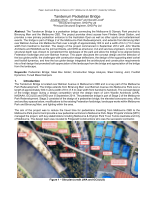Bridges

- Publication no: ABC2017-076-17
- Published: 21 April 2017
- PDF (free) Download
The Tanderrum Bridge is a pedestrian bridge connecting the Melbourne & Olympic Park precinct to Birrarung Marr and the Melbourne CBD. The project provides direct access from Flinders Street Station, and provides a new primary pedestrian entrance to the Australian Open as well as other sports and entertainment events. The bridge is part of Stage 2 of the Melbourne Park Redevelopment, and extends from Birrarung Marr over Batman Avenue into Melbourne Park over a length of approximately 300 m and a width of 8 m.
The design of the project commenced in August 2014 with John Wardle Architects and NADAAA as the joint architects, and GHD as structural, civil and services engineers. A low profile structural depth was chosen to complement the landscape of the park and allow the bridge to be aligned below Federation footbridge and over Batman Avenue.
This paper discusses the concept design and the selection of the box girder profile, the challenges with construction stage deflections, design of the supporting steel corbel and footfall dynamics, and how the box girder design integrated the architectural and construction requirements into a final design that promoted both appreciation of the landscape from the bridge and appreciation of the bridge from the landscape.
- 1. Introduction
- 2. Design
- 2.1. Concept design
- 2.2. Bridge description
- 2.2.1. Box girder
- 2.2.2. Blade piers
- 2.2.3. Belvedere
- 2.2.4. Bridge balustrade
- 3. Analysis
- 3.1. Construction stage deflections
- 3.2. Shallow depth halving joint
- 3.3. Bridge dynamics and footfall analysis
- 4. Construction
- 4.1. Erection of steel box girders
- 4.2. Asymmetric box girder halves
- 4.3. Box girder fabrication for large precambers
- 4.4. Dynamic testing of as-built structure and tuned mass dampers
- 5. Conclusions
- 6. Acknowledgements
- 7. References
